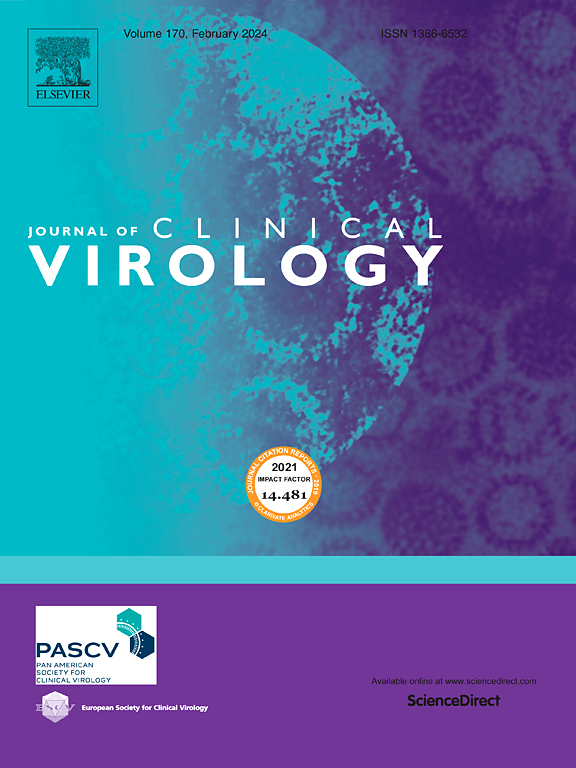The Human Papillomavirus (HPV) Laboratory e-Manual: A comprehensive guide for HPV testing and research
IF 3.4
3区 医学
Q2 VIROLOGY
引用次数: 0
Abstract
Background
Human Papillomavirus (HPV) vaccination and HPV-based cervical cancer screening are central pillars of the World Health Organization (WHO) global cervical cancer elimination strategy. The WHO HPV Laboratory Manual, published in 2009, has provided essential guidance to promote an internationally comparable quality of HPV testing for many years. As the development in this area is rapid, the Global Network of National HPV Reference Laboratories considered that there is a need for an updated HPV Laboratory e-Manual to serve as a comprehensive and interactive resource for professionals engaged in quality-assured HPV testing for research and/or HPV-based cancer control.
Content
The HPV Laboratory e-Manual covers key areas, including laboratory quality assurance, HPV taxonomy and risk association, collection and handling of specimens, nucleic acid extraction, HPV detection and typing, HPV serology, data management, and the use of international standards. It provides up-to-date protocols and best practices to enhance accuracy and reliability of HPV testing. Interactive features allow for real-time updates, making it a dynamic resource for laboratories worldwide. The e-Manual is freely available at: https://www.hpvcenter.se/hpv-laboratory-manual/.
Collaborators
The e-Manual has been developed by international experts from 11 countries, including contributors from the International HPV Reference Center (IHRC, Sweden), the CDC’s Global HPV Reference Laboratory (USA), and multiple National HPV Reference Laboratories (NRLs). The standard procedure for writing a chapter was that 2 NRLs authored the chapter and 1 other NRL reviewed it.
Conclusion
The HPV Laboratory e-Manual represents a step toward global harmonization in laboratory methodologies for HPV testing, underpinning both research and cervical cancer control efforts.
人类乳头瘤病毒(HPV)实验室电子手册:HPV检测和研究的综合指南
人类乳头瘤病毒(HPV)疫苗接种和基于HPV的宫颈癌筛查是世界卫生组织(WHO)全球消除宫颈癌战略的中心支柱。世卫组织2009年出版的《人乳头瘤病毒实验室手册》多年来为促进具有国际可比性的人乳头瘤病毒检测质量提供了基本指导。由于这一领域的发展迅速,国家HPV参考实验室全球网络认为有必要更新HPV实验室电子手册,为从事有质量保证的HPV检测研究和/或基于HPV的癌症控制的专业人员提供全面和互动的资源。HPV实验室电子手册涵盖了关键领域,包括实验室质量保证、HPV分类和风险关联、标本收集和处理、核酸提取、HPV检测和分型、HPV血清学、数据管理和国际标准的使用。它提供了最新的协议和最佳做法,以提高HPV检测的准确性和可靠性。交互功能允许实时更新,使其成为全球实验室的动态资源。电子手册由来自11个国家的国际专家编写,其中包括来自国际HPV参考中心(IHRC,瑞典)、疾病预防控制中心全球HPV参考实验室(美国)和多个国家HPV参考实验室(nrl)的贡献者。写一章的标准程序是两个NRL撰写一章,另外一个NRL审核一章。结论HPV实验室电子手册是朝着全球统一HPV检测实验室方法迈出的一步,为研究和宫颈癌控制工作奠定了基础。
本文章由计算机程序翻译,如有差异,请以英文原文为准。
求助全文
约1分钟内获得全文
求助全文
来源期刊

Journal of Clinical Virology
医学-病毒学
CiteScore
22.70
自引率
1.10%
发文量
149
审稿时长
24 days
期刊介绍:
The Journal of Clinical Virology, an esteemed international publication, serves as the official journal for both the Pan American Society for Clinical Virology and The European Society for Clinical Virology. Dedicated to advancing the understanding of human virology in clinical settings, the Journal of Clinical Virology focuses on disseminating research papers and reviews pertaining to the clinical aspects of virology. Its scope encompasses articles discussing diagnostic methodologies and virus-induced clinical conditions, with an emphasis on practicality and relevance to clinical practice.
The journal publishes on topics that include:
• new diagnostic technologies
• nucleic acid amplification and serologic testing
• targeted and metagenomic next-generation sequencing
• emerging pandemic viral threats
• respiratory viruses
• transplant viruses
• chronic viral infections
• cancer-associated viruses
• gastrointestinal viruses
• central nervous system viruses
• one health (excludes animal health)
 求助内容:
求助内容: 应助结果提醒方式:
应助结果提醒方式:


